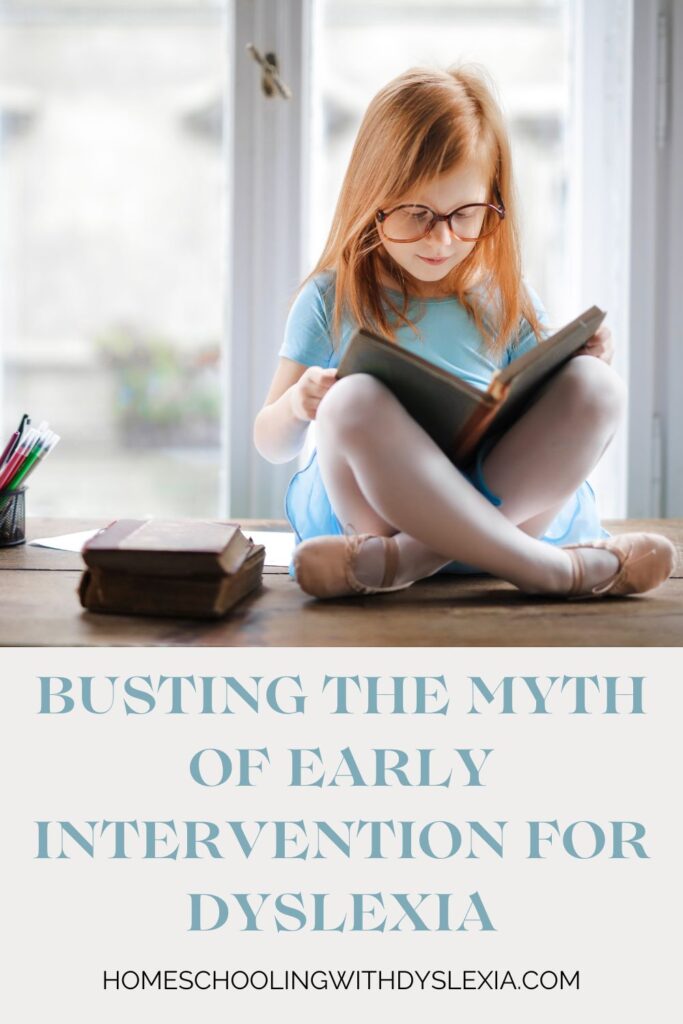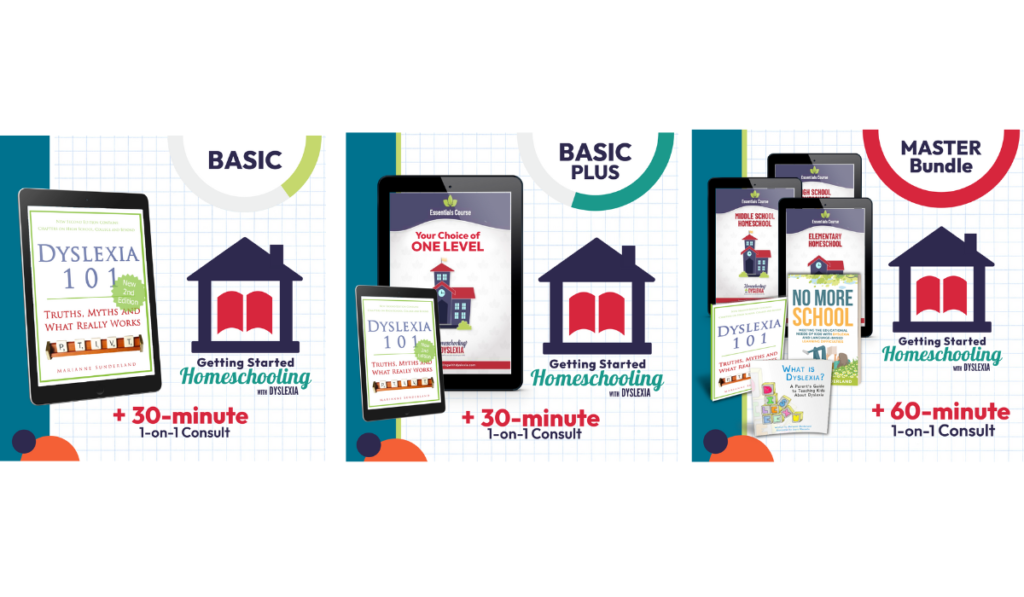Early intervention is the battle cry of dyslexia experts across the world, yet much of the push for early intervention for dyslexia and catching kids up to their peers is based on the traditional school model and may not be necessary at all.

I saw a quote online this week.
Maybe you have seen it too.
Or something like it.
Something that quotes research saying if your dyslexic kids don’t receive the right kinds of intervention for their learning struggles EARLY, that they will be irreparably harmed, always be behind, or never read fluently, etc.

I have SO many problems with this statement about early intervention for dyslexia.
Most if not all of my issues with this quote stem from the MAJOR differences between homeschooling a child with dyslexia and a dyslexic child being a part of the traditional educational model.
The deficits of the traditional school model are the only reason there is any truth to this this statement.
Let’s break this quote down line by line:
“The best time for struggling readers to catch up is in the first year of school.“
First of all the term ‘catching up’ is based on the deficit approach to dyslexia. The deficit approach to dyslexia implies that there is something wrong with our kids that needs to be fixed.
This is a normal response to the normal delayed learning of language that people with dyslexia experience IF they are surrounded by children that learn traditionally and IF the goal is to catch them up and make them more like traditional learners. In this approach, dyslexia is a deficit that needs to be fixed.
Read this to learn why I don’t look at dyslexia as a deficit any more.
In the first year of school, kindergarten for most children, kids are 5 or 6 years old. In my experience teaching kids with dyslexia to read and working with 1000s of parents who are working with their own kids, kids with dyslexia are often unable to master the concepts of fluent reading in kindergarten or first grade (roughly 5-7 years old).
They need time and lots of practice to learn to read. I don’t know any 5-7 year old kids with dyslexia who were able to read, write, or spell at the level of their peers who learn traditionally no matter how much early intervention and tutoring they have received.
This statement is misleading and causes unnecessary stress. Very few, if any, dyslexic kids are getting the help they need in kindergarten or first grade within the traditional school system anyway. If your kids have received appropriate interventions in the first year of school and caught up to their peers, please let me know!
Next line…
After that, it’s a law of diminishing returns and it takes more and more resources to try to bring these children up to speed.
The second sentence is also misleading. It doesn’t take more resources to teach a child with dyslexia to read as they get older. Teaching kids with dyslexia to read is not a mystery. Research clearly shows what methods work to teach people with dyslexia to read (Orton-Gillingham) and depending on the severity of a child’s processing lags, it can take at least a few or possibly many years for a child to master the concepts of language and become a fluent reader. Spelling takes even longer to master.
Perhaps Dr. Snow is referring to the additional accommodations and support that are needed for an older child with dyslexia to keep up with what is being taught in the traditional classroom. Since they are moving too quickly for most dyslexic kids, rarely providing appropriate accommodations, and many teachers are unaware of what dyslexia is and how to help the students who have it, there can be a lot of problems.
Without the right kinds of support, dyslexic students in these environments often struggle to keep up with content which progresses despite their lack of understanding and mastery. This results in kids with dyslexia getting lost and falling behind which results in stress which leads to anxiety.
In my experience, while some kids with dyslexia learn to read in elementary school, it is completely normal for their learning to really take off in middle school. Spelling can be even later. There is something in a dyslexic child’s brain development that takes place in middle school that allows language learning to become much easier than in the elementary years, especiallly kindergarten and first grade.
Next line…
All the while, of course, they are missing out on academic content, and often developing mental health problems such as anxiety as a result of their reading problems and the embarrassment attached to these.
Again, ‘missing out on academic content’ is only because kids with dyslexia are not being taught the way they learn or given appropriate levels of support so they can work at their intellectual ability within a traditional school setting. There is no reason for them to miss anything if their unique way of learning is accommodated and they are allowed to learn in ways they naturally learn and at their unique pace.
‘Often developing mental health problems, such as anxiety, as a result of their reading problems and the embarrassment attached to these.’
I have so much to say about this.
Kids who are not taught with methods that work will not be reading and writing at grade level. This is the cause of anxiety. Imagine being in a learning environment all day long where you are unable to access the material (because you can’t read it) or comprehend the material (because their foundation is not strong). Anxiety forms when students are not given the support they need and then are judged by the same standards as traditional learners.
In conclusion…
Why early intervention for dyslexia may not be the answer.
The real goal of reading instruction should be to provide individualized instruction that allows for the unique differences not only in dyslexic children, but also for individual differences among children with dyslexia.
—-
This quote might be helpful for school administrators and those who are responsible for the education of children with learning differences within the traditional school system.
School administrators are the ones who should be concerned about these statistics and be making changes. All children should be screened for dyslexia before there are issues. Schools could easily switch to evidence-based reading programs for ALL students so the kids with dyslexia can be taught how they learn and run less of a chance of falling behind their peers.
School administrators are the ones who should be concerned about children developing anxiety about learning and taking action to prevent it.
For parents of children with dyslexia, this quote adds an unfair and impossible burden to diagnose a child before the first year of school and get them the help they need, or else.
Appropriate Intervention for Students With Dyslexia
If your child is currently in a traditional learning environment and struggling, getting started homeschooling is easier than you think!
Homeschooling your kids is a big responsibility BUT there are a TON of benefits.
If you are wondering what those benefits are, read this post: 10 Reasons to Homeschool Your Kids With Dyslexia
Resources for Getting Started Homeschooling Kids With Dyslexia
Free Download: Guide to Homeschooling Kids With Dyslexia
Click here to get the free guide to homeschooling kids with dyslexiaMy latest book: No More School: Meeting the Educational Needs of Kids With Dyslexia and Language-Based Learning Difficulties
Getting Started Homeschooling Master Class Bundles
These bundles of courses, books, and optional 1:1 consulting packages were designed to teach you what has taken me nearly 30 years to learn teaching my own kids with dyslexia.
Visit the Getting Started Homeschooling Information Page to Learn More






Thank you for your most recent emails and blog posts about this topic. We have had my almost 9 year old son in private tutoring since he was 7 1/2. He just wasn’t making very much progress at all. But, I have heard all the stats about how important early intervention is! I was wanting to call it quits on the tutoring and just give his mind time to mature, and to also hopefully give him time to develop some internal motivation for learning to read. Your encouragement in this area helped us to make the decision and I’m so relieved not to be spending time and money on tutoring that wasn’t producing the kind of results we would want from such a costly intervention. We’ll keep working on things at home in smaller, more manageable chunks, and I have hope that he will enter those older elementary/middle school years and we will see something click for him, just like I’ve read about many others.
You make some excellent points here, but I think it’s important to note that Dr. Snow was referring to a very real problem within far too many school systems. Many districts have been using curricula that doesn’t actually teach kids to read. When parents express concern, they’re told that their child will catch up – magically, and without intervention. What she’s saying is vitally important for the many children in public schools, many of whom could read just fine if taught correctly. Those kids really will have a hard time catching up, since in public school, they’ll need to be able to read well in other subjects such as science and history and will fall behind their peers.
What you’re showing here is that as homeschoolers, you’re taking control of this situation. Your kids won’t be embarrassed by being asked to read in front of their classmates. If they can’t read their history book, you can find other methods. Most important, you can choose a curriculum or method that works.
You do have me thinking about how much the research I’ve been reading about how kids learn to read might be a little different for homeschoolers. I’m going to look into that.
At the same time, though, I want to be sure Dr. Snow is appreciated for all she’s done for this field and for children. It’s great that you pointed out how these kinds of statements might not apply to homeschooled children. But the post itself is excellent in explaining why too many kids aren’t learning to read in public schools. Here’s a link to the full post:
https://pamelasnow.blogspot.com/2019/08/dear-parents-welcome-to-confusing-world.html
In regard to this statement,
“There is something in a dyslexic child’s brain development that takes place in middle school that allows language learning to become much easier than in the elementary years…”
Middle school is about where all students’ reading vocabulary acquisition collides with their receptive/speaking vocabulary. It’s not unique to people with dyslexia. The number of words known in speaking combined with exposure to the morphological and orthographic structures allows for a much greater number of words to be decoded and synthesized.
I needed to read this. Thank you! I’m a mom to a 10 year old dyslexic girl, and she learned to read fluently in 3rd and 4th grade using the OG method in a dyslexic program within a traditional school. We now homeschool her, which she and we love. She can learn on her schedule, not theirs. I agree there’s no rush to diagnose within the first year and rush to play catch up. She struggles with spelling (thanks for mentioning that can take even longer than reading fluently), but I can already see how her mind is developing very quickly as she approaches the middle school years. Having a more relaxed approach to her education has significantly increased her self esteem and improved her comprehension.
The implication that complete reading remediation by age 6 or 7 is the only hope your child has for academic success has always bothered me. Our daughter was identified as potentially dyslexic in pre-school, and officially diagnosed at the end of 1st grade when she was 7 years old. Even so, we felt “behind” in the race towards literacy. She’s now 13 and still not reading on grade level despite years of intervention. She developed school-related anxiety somewhere around 3rd grade, right as the pandemic hit and she was forced into two years of online school. That’s when I saw first-hand just how ill-suited the traditional school system is for her. Thankfully we were able to get her into an online school for dyslexic learners and she is thriving now. She might still be a slow reader, but she is happy and loves learning once again.
Alli J, What is the name of the online school for dyslexlic learners that your daughter attends? i would love to know!
Thank you for this article of hope! Nothing is more stressful than the “race for literacy” with a child who’s simply not ready.
I agree with you so much! Dyslexia is a multi billion dollar industry of concerned, parents, testing, programs, schools, and most of all governmental funding. The accepted norms keep all of this going. You are smart not to publish your last name.
To sum it up, the area of the brain related to reading and phonics develops a few years later. But the word “behind” is inaccurate.
There are thousands of elementary dyslexia programs. There are a couple dozen middle school programs. Possibly a few high schools, and zero colleges. We are simply talking about a delay.